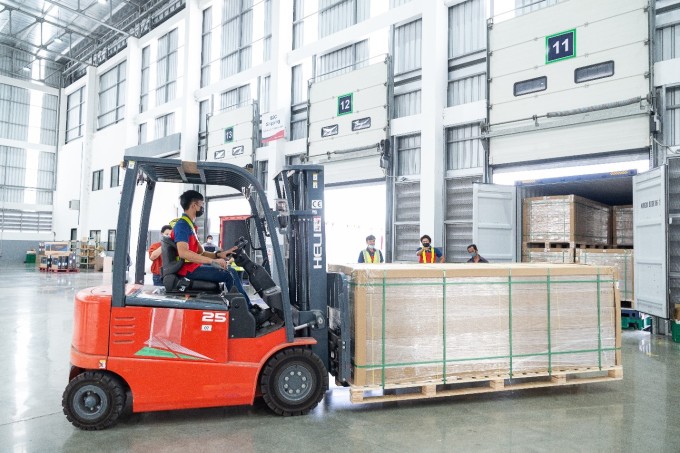Minister of Industry and Trade Nguyen Hong Dien speaks at the Forum Plenary Session
Logistics market in Vietnam is assessed by the business community (DN) and international organizations as a potential market for strong development , especially after the Covid-19 pandemic is under control and production and business activities recover and grow again.
Minister of Industry and Trade Nguyen Hong Dien emphasized so at the plenary session of the Vietnam Logistics Forum 2021 organized by the Ministry of Industry and Trade in collaboration with relevant agencies.
Restore supply chain, develop logistics after the pandemic
2021 is the socio-economic year of Vietnam that is heavily affected by the 4th Covid-19 epidemic, with periods of social distancing and prolonged disruption of production and circulation. That context puts the logistics service industry in a position that is both directly affected and has to show a strong resilience to maintain the operation of domestic supply chains as well as import and export goods.
At the same time, new trends, models and protocols in the production, circulation and consumption of goods globally also create motivation and pressure for innovation in terms of technology, thinking, human resources and mechanisms. management, if you do not want to be left behind in today’s deeply integrated environment.
At Symposium 1: “Restoring supply chains, developing logistics after the pandemic” within the framework of Vietnam Logistics Forum 2021, Mr. Phan Duc Hieu – Standing Member, Economic Committee of the National Assembly – received The Covid-19 pandemic has slowed down socio-economic development, especially, the pandemic in the past 2 years has had a strong impact on the transport service industry. However, “on a positive note, the logistics industry in recent years has been very resilient in contributing to the country’s economic development. The logistics industry plays a dual role, both creating its own values of the economic sector and supporting production and business activities in the context of the epidemic, which is still having very unpredictable developments.” – Mr. Phan Duc Hieu confirm.
From a practical perspective, Mr. Le Quang Trung, Deputy General Director of Vietnam Maritime Corporation – said that the biggest difficulty logistics enterprises are facing is dealing with disruptions in the service supply chain. to maintain business continuity and the skyrocketing of ocean freight rates as well as the shortage and imbalance of containers around the world. The issue of organizing production, allocating appropriate human resources while still ensuring safety, regulations on epidemic prevention such as 5K or 3 on-site implementation…
“Besides, Vietnamese import-export enterprises currently have more than 10 types of fees to be charged for an export container such as: Document fee, loading and unloading fee, container cleaning fee, container balancing fee, weight declaration fee; The issue of arbitrarily imposed exchange rates… is very heavy and troublesome,” said Mr. Le Quang Trung.
According to statistics of the Vietnam Logistics Business Association (VLA), about 15% of enterprises have a 50% decrease in revenue compared to 2020 and more than 50% of enterprises reduce the number of domestic and international logistics services from 10%. – 30% over the same period in 2020.
According to the Vietnam Association of Seafood Exporters and Producers (VASEP), from November 2020, most shipping lines announced an increase in container freight rates, with an increase of 2-10 times (depending on the destination). ). Along with the inadequacies in freight rates, the surcharges charged by foreign shipping lines also become a burden for Vietnamese shippers.
Sharing the story of the textile industry, Mr. Than Duc Viet, General Director of Garment 10 Corporation – said that, like other industries such as leather, footwear, plastic, wooden furniture… for many years, the textile and garment industry Vietnam still has to depend on input materials from foreign imports. This proportion is quite large, showing the passivity and dependence on supply from other countries around the world. This is also one of the major potential “risks” of the industry when the supply chain is disrupted.
According to the Vietnam Textile and Apparel Association, the import turnover of raw materials and accessories in the first 9 months of 2021 is estimated at 18 billion USD, up 27.9% over the same period in 2020. The main imported materials include: cotton, fiber yarns, fabrics, accessories… However, new generation FTAs such as: CPTPP, EVFTA… require the rules of origin for yarns and fabrics to be produced in Vietnam or other FTA bloc countries to enjoy preferential treatment. tax incentives. But in fact, the textile industry still has to import a large amount of raw materials from sources outside the FTA.
Faced with this fact, the General Director of Garment 10 Corporation suggested that the Government should plan a development strategy for the field of manufacturing raw materials and accessories for the textile and garment industry to create a closed and synchronous value chain, ensuring the demand for goods and services. domestic and for export. At the same time, it is necessary to reposition so that the world knows that Vietnam’s textile and garment industry is not only an industry with cheap labor and mass production, but also includes businesses with added value and social responsibility.
On the other hand, shaping new, more breakthrough directions for thousands of dollars







admin